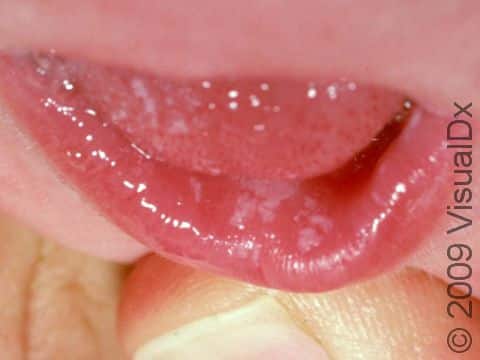Thrush (Oral Candidiasis)
Oral candidiasis, most commonly known as thrush, is a very common disease caused by an overgrowth of yeast in the mouth and/or throat. The most common yeast causing thrush is called Candida albicans.
Who's At Risk?
Thrush is very common in newborns and infants. Note that thrush is not passed from infant to infant. However, it can be passed to the baby during childbirth in the vaginal canal or during breastfeeding.
Older infants more likely to develop thrush are those:
- Taking oral antibiotics.
- Undergoing chemotherapy.
- With an immune disorder.
Other factors that can predispose infants to thrush include leaving a bottle propped in their mouth during feedings and improper wiping after feedings.
Signs & Symptoms
Thrush may appear as white or pale-yellow papules (raised, solid bumps) or plaques (flat, solid areas) on the inner surfaces of the mouth and throat, the tongue, and the lips. It may resemble cottage cheese or milk curds. Scraping off these membranes may be difficult and may leave slightly bleeding sores. Thrush can sometimes appear as red, sore areas.
Self-Care Guidelines
Thrush may make eating and drinking uncomfortable, and babies with thrush may become dehydrated as a result. Therefore, it is important to make sure the baby maintains good nutrition and fluid intake while infected with thrush.
Treatments
The medical professional will offer treatment that helps kill the overgrown yeast with an antifungal, such as:
- Oral nystatin.
- Oral or intravenous fluconazole.
Visit Urgency
Thrush requires prescription medication, which your baby’s medical professional can prescribe after an evaluation. If the baby has an immune deficiency, it is particularly important that they receive prompt treatment to keep the yeast out of the bloodstream and prevent it from infecting other parts of the body. If any caregiver for the baby has a Candida infection, the caregiver should also be treated.
References
Bolognia J, Schaffer JV, Cerroni L. Dermatology. 4th ed. Philadelphia, PA: Elsevier; 2018.
James WD, Elston D, Treat JR, Rosenbach MA. Andrew’s Diseases of the Skin. 13th ed. Philadelphia, PA: Elsevier; 2019.
Kang S, Amagai M, Bruckner AL, et al. Fitzpatrick’s Dermatology. 9th ed. New York, NY: McGraw-Hill Education; 2019.
Paller A, Mancini A. Paller and Mancini: Hurwitz Clinical Pediatric Dermatology. 6th ed. St. Louis, MO: Elsevier; 2022.
Last modified on June 17th, 2024 at 9:45 am

Not sure what to look for?
Try our new Rash and Skin Condition Finder

